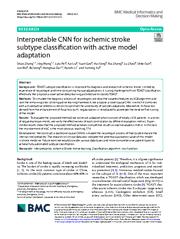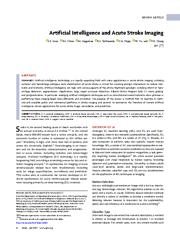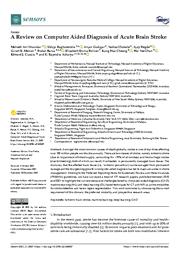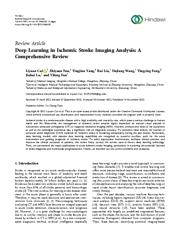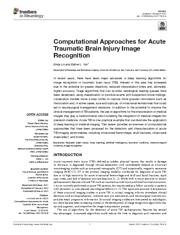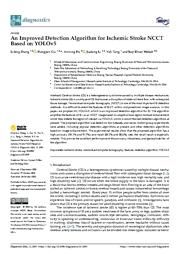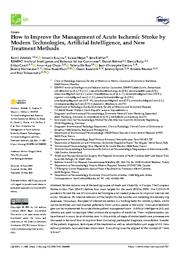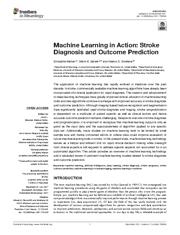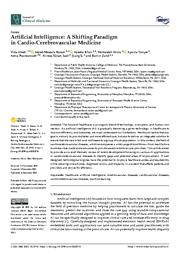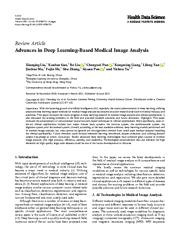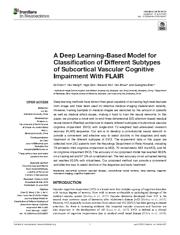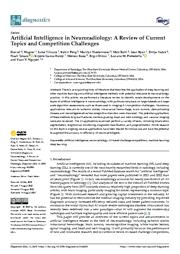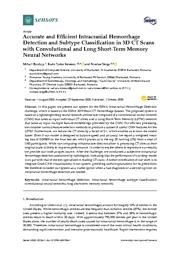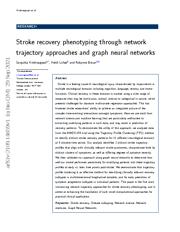A copy of this work was available on the public web and has been preserved in the Wayback Machine. The capture dates from 2022; you can also visit the original URL.
The file type is application/pdf.
Filters
Interpretable CNN for ischemic stroke subtype classification with active model adaptation
2022
BMC Medical Informatics and Decision Making
Background TOAST subtype classification is important for diagnosis and research of ischemic stroke. ...
Utilizing active learning framework, we propose a novel causal CNN, in which it combines with a mixed active selection criterion to optimize the uncertainty of samples adaptively. ...
Meanwhile, our deepest gratitude goes to the anonymous reviewers and editors for their careful work and thoughtful suggestions that have helped improve this paper substantially. ...
doi:10.1186/s12911-021-01721-5
pmid:34986813
pmcid:PMC8729146
fatcat:hw27g2yji5e3pekuffnwdormom
Artificial Intelligence and Acute Stroke Imaging
2020
American Journal of Neuroradiology
Artificial intelligence technology is a rapidly expanding field with many applications in acute stroke imaging, including ischemic and hemorrhage subtypes. ...
Artificial intelligence can help with various aspects of the stroke treatment paradigm, including infarct or hemorrhage detection, segmentation, classification, large vessel occlusion detection, Alberta ...
ACKNOWLEDGMENTS The authors thank Aidoc, Avicenna, Brainomix, RapidAI, and Viz.ai for providing information regarding commercially available products and sample images of their applications for publication ...
doi:10.3174/ajnr.a6883
pmid:33243898
pmcid:PMC7814792
fatcat:uwvjtq42ejfzjoi46eqlublmya
A Review on Computer Aided Diagnosis of Acute Brain Stroke
2021
Sensors
There are two classes of stroke, namely ischemic stroke (due to impairment of blood supply, accounting for ~70% of all strokes) and hemorrhagic stroke (due to bleeding), both of which can result, if untreated ...
status and challenges faced by computer aided diagnosis (CAD), machine learning (ML) and deep learning (DL) based techniques for CT and MRI as prime modalities for stroke detection and lesion region segmentation ...
Regression Automated prognosis for post-treatment ischemic stroke 2016 Chen et al. [121] CT CNN Early stroke detection (ischemic) system with CNN 2017 Lucas et al. [122] CT 3D U-net appended with Convolutional ...
doi:10.3390/s21248507
pmid:34960599
pmcid:PMC8707263
fatcat:zc4gtjhkoje2jotcqr5gvlatu4
Deep Learning in Ischemic Stroke Imaging Analysis: A Comprehensive Review
2022
BioMed Research International
Particularly, deep learning models with massive data learning capabilities are recognized as powerful auxiliary tools for the acute intervention and guiding prognosis of ischemic stroke. ...
Ischemic stroke is a cerebrovascular disease with a high morbidity and mortality rate, which poses a serious challenge to human health and life. ...
In ischemic stroke lesion analysis, the model, including CNN and transformer for encoding and the multihead cross-attention (MHCA) module for decoding, leads to stroke lesion morphology and edges with ...
doi:10.1155/2022/2456550
pmid:36420096
pmcid:PMC9678444
fatcat:5sxmcvsgfnb7bbui3y23w5hc5m
Computational Approaches for Acute Traumatic Brain Injury Image Recognition
2022
Frontiers in Neurology
Triage algorithms that can re-order radiological reading queues have been developed, using classification to prioritize exams with suspected critical findings. ...
Localization models move a step further to capture more granular information such as the location and, in some cases, size and subtype, of intracranial hematomas that could aid in neurosurgical management ...
(92) reported and publicly released a deep learning model that segmented acute ischemic stroke lesions on diffusionweighted imaging (DWI) with a Dice coefficient of 0.76, similar to interrater agreement ...
doi:10.3389/fneur.2022.791816
pmid:35370919
pmcid:PMC8964403
fatcat:oj67mgbelbed5g5i4474gaklxi
An Improved Detection Algorithm for Ischemic Stroke NCCT Based on YOLOv5
2022
Diagnostics
Ischemic stroke (IS) is a subtype of CS that causes a disruption of cerebral blood flow with subsequent tissue damage. ...
In this paper, we propose AC-YOLOv5, which is an improved detection algorithm for IS. ...
Chalela et al. evaluated NCCT to screen acute ischemic stroke. The result was only 56 acute IS patients were screened from 217 acute IS patients, with a sensitivity of 26% [21] . ...
doi:10.3390/diagnostics12112591
pmid:36359435
pmcid:PMC9688968
fatcat:lhzunoun2zafhoe24na2lbe2sq
How to Improve the Management of Acute Ischemic Stroke by Modern Technologies, Artificial Intelligence, and New Treatment Methods
2021
Life
Stroke remains one of the leading causes of death and disability in Europe. The European Stroke Action Plan (ESAP) defines four main targets for the years 2018 to 2030. ...
Innovative technologies can be implemented for acute stroke patient management soon. Artificial intelligence (AI) and robotics are used increasingly often without the exception of medicine. ...
The perfusion-diffusion mismatch model can be outperformed by CNN-based models. ...
doi:10.3390/life11060488
pmid:34072071
fatcat:knirhcz2zvbmzh7wscu26yacuu
Machine Learning in Action: Stroke Diagnosis and Outcome Prediction
2021
Frontiers in Neurology
In stroke, commercially available machine learning algorithms have already been incorporated into clinical application for rapid diagnosis. ...
The creation and advancement of deep learning techniques have greatly improved clinical utilization of machine learning tools and new algorithms continue to emerge with improved accuracy in stroke diagnosis ...
• (0.465- 0.533; 0.170-0.328) Giri et al. (33) Ischemic stroke 1D CNN vs. various Leave-one-out • 32 -AIS 15-min EEG with 24 • Accuracy -0.86 Leave-one-out In areas with Time to apply EEG diagnosis by ...
doi:10.3389/fneur.2021.734345
pmid:34938254
pmcid:PMC8685212
fatcat:xr7uilf2sneajamrq5ckxyy3ue
Artificial Intelligence: A Shifting Paradigm in Cardio-Cerebrovascular Medicine
2021
Journal of Clinical Medicine
In this context, the field of cardio-cerebrovascular diseases, which encompasses a wide range of conditions—from heart failure to stroke—has made some advances to provide assistive tools to care providers ...
technological engines have the potential to improve healthcare access and equitability while reducing overall costs, diagnostic errors, and disparity in a system that affects patients and providers and strives for ...
[63] developed an automated stroke subtype classification using radiology and progress reports and showed agreement with the manual TOAST (Trial of ORG 10172 in acute stroke treatment) [64] classification ...
doi:10.3390/jcm10235710
pmid:34884412
fatcat:uzn2wx5tzvaovme4h7p36z775q
Advances in Deep Learning-Based Medical Image Analysis
2021
Health Data Science
With the booming growth of artificial intelligence (AI), especially the recent advancements of deep learning, utilizing advanced deep learning-based methods for medical image analysis has become an active ...
Overall, according to the best available evidence, deep learning models performed well in medical image analysis, but what cannot be ignored are the algorithms derived from small-scale medical datasets ...
[64] used a U-shaped network (Res-CNN) to automatically segment acute ischemic stroke lesions from multimodality MRIs, and the average Dice coefficient was 0.742. Zhao et al. ...
doi:10.34133/2021/8786793
pmid:38487506
pmcid:PMC10880179
fatcat:d6nkb4yoxrcgni4y5owju5pnh4
A Deep Learning-Based Model for Classification of Different Subtypes of Subcortical Vascular Cognitive Impairment With FLAIR
2020
Frontiers in Neuroscience
Deep learning methods have shown their great capability of extracting high-level features from image and have been used for effective medical imaging classification recently. ...
The accuracy of our proposed model has reached 98.6% on a training set and 97.3% on a validation set. The test accuracy on an untrained testing set reaches 93.8% with robustness. ...
Considering the importance of VaMCI subtypes for clinical decision, and the possibility for image classification suggested by limited neuroimaging studies, we constructed an efficient 3D-CNN model to achieve ...
doi:10.3389/fnins.2020.00557
pmid:32625048
pmcid:PMC7315844
fatcat:qoxyauz25few7omx2gqo6driqi
Accurate and Efficient Intracranial Hemorrhage Detection and Subtype Classification in 3D CT Scans with Convolutional and Long Short-Term Memory Neural Networks
[article]
2020
arXiv
pre-print
For efficient processing, we consider various feature selection methods to produce a subset of useful CNN features for the LSTM. ...
After the challenge, we conducted a subjective intracranial hemorrhage detection assessment by radiologists, indicating that the performance of our deep model is on par with that of doctors specialized ...
They employed a cascaded model, with an RNN for intracranial hemorrhage detection and another RNN for subtype classification. ...
arXiv:2008.00302v3
fatcat:i6hzazwwwna5hbryxy6ufodmva
Artificial Intelligence in Neuroradiology: A Review of Current Topics and Competition Challenges
2023
Diagnostics
Numerous applications relevant to ischemic stroke, intracranial hemorrhage, brain tumors, demyelinating disease, and neurodegenerative/neurocognitive disorders were discussed. ...
The AI applications examined perform a variety of tasks, including localization, segmentation, longitudinal monitoring, diagnostic classification, and prognostication. ...
Ischemic Stroke Stroke is a leading cause of death and the number one cause of serious long-term disability in the United States, with ischemic stroke accounting for most stroke types [7] . ...
doi:10.3390/diagnostics13162670
pmid:37627929
pmcid:PMC10453240
fatcat:eevdxlkyjbfodj4woysetendje
Accurate and Efficient Intracranial Hemorrhage Detection and Subtype Classification in 3D CT Scans with Convolutional and Long Short-Term Memory Neural Networks
2020
Sensors
For efficient processing, we consider various feature selection methods to produce a subset of useful CNN features for the LSTM. ...
After the challenge, we conducted a subjective intracranial hemorrhage detection assessment by radiologists, indicating that the performance of our deep model is on par with that of doctors specialized ...
While hemorrhagic strokes are less frequent than ischemic strokes (87%), the former ones present a higher mortality rate. ...
doi:10.3390/s20195611
pmid:33019508
pmcid:PMC7582288
fatcat:3xkw6dmoxnezrhuimwzmcvikaa
Stroke recovery phenotyping through network trajectory approaches and graph neural networks
[article]
2021
arXiv
pre-print
Our analysis identified 3 distinct stroke trajectory profiles that align with clinically relevant stroke syndromes, characterized both by distinct clusters of symptoms, as well as differing degrees of ...
We demonstrate that trajectory profile clustering is an effective method for identifying clinically relevant recovery subtypes in multidimensional longitudinal datasets, and for early prediction of symptom ...
Lindgren for their diligent critical review and comments on the manuscript. ...
arXiv:2109.14659v1
fatcat:ktffypd2lrhlpaqohl33bzvyn4
« Previous
Showing results 1 — 15 out of 111 results

